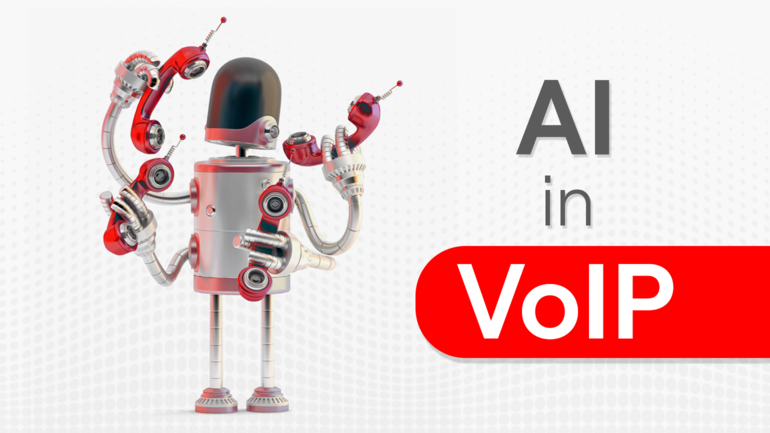Artificial intelligence (AI) is currently one of the most talked-about and experimented-with technologies in practically every sector. Being amongst the most significant new technical advances, AI has major implications for Voice over Internet protocol (VoIP) and Unified Communications (UC).
With its numerous capabilities, VoIP telephony is already transforming the communication capabilities of many businesses. However, when AI technology becomes an active participant, the efficiency and potential of this market will skyrocket. So, let us see how AI will revolutionize and influence VoIP, and how this technology will become an essential component in all corporate processes.
How AI works in VoIP
VoIP service providers are always adding new features to their VoIP services in order to attract consumers on both individual and business levels. With the inclusion of AI in communications, new market opportunities are anticipated to emerge. This is why AI has become an essential factor in several VoIP and business phone service features.
Artificial intelligence is having an impact on the future of VoIP and UC and can help organizations improve their operations. More specifically, AI is transforming the VoIP sector by increasing the efficiency of different communication systems such as conferencing, IVR systems and chatbots.
The telecommunications business as a whole is rapidly expanding and evolving. As a result, development and innovation is occurring in the VoIP context as service providers deliver improved capabilities to end-users for greater ease, dependability, scalability, profitability and flexibility.
What benefits does AI bring to VoIP?
Interactive voice response (IVR) systems
An IVR system serves to answer client inquiries automatically, which is highly useful for dealing with huge call volumes. This functionality is enhanced by AI working in the background to gather all relevant client data, such as personal information and previous transactions, in order to handle a query. For more complex questions, the AI “assistant” passes relevant information to a company employee, who will be able to service the client much better.
Chatbot functions
Chatbots are computer programs that are supposed to deliver hassle-free customer assistance by automating tasks that are given to them via text or speech. They’re designed for IVR-style automated consumer interactions, which are taken to the next level by AI bots performing duties that are normally performed by people. AI bots are able to plan meetings, organize conferences, invite attendees, greet visitors, manage time, and much more.
Consumer satisfaction
If you work in a firm or organization that handles hundreds of calls each day, VoIP with an integrated AI system can improve productivity, with call traffic being efficiently managed by AI systems. If there are too many calls, AI can divert selected calls to another available person or to the department that can best deal with the caller using machine-learned approaches. As a result, having a service staff that is used effectively saves time and reduces both the customer’s and the employee’s aggravation.
Conferencing capabilities
Web conferencing has evolved over time as the internet speed has increased and telecom technologies have advanced. AI takes this a step further with real-time language translation and speech recognition technology, which tremendously helps enterprises handle many geographical locations and stakeholders from various backgrounds. AI-powered web conferencing may even deliver intelligent suggestions and relevant data to help steer the interactions of participants and ensure a productive conference.
Voice-to-text
Voice-to-text technology has substantially improved thanks to AI, making this service more accurate despite issues such as ambient noise, various user dialects and speech patterns. Indeed, AI-enhanced VoIP systems are growing more adept at transcribing phone conversations into text files. Written transcriptions use up little storage space and are simple to save and index for recordkeeping. This can assist businesses in creating text-based records, which are critical for maintaining transparency, providing insights, and settling disagreements, among other things.
Analytics
AI can help organizations by monitoring real-time speech patterns, identifying the speaker’s present mood and any changes in mood. AI-enhanced VoIP systems may analyze and evaluate the meaning and tone of words spoken during a call, as well as past call transcriptions. As a result, these tools may give insights into consumer behavior, motives and preferences, as well as assist businesses in determining how to enhance customer experience during phone conversations, allowing employees to conclude talks faster and efficiently meet the caller’s needs.
Pattern identifications
Recognizing patterns is another key AI use that may assist businesses in developing corporate processes, strategies and workflows. AI is capable of complex pattern recognition and is already used in Amazon’s Alexa, Google’s Nest, and other products. The potential industrial and corporate applications of such pattern-detecting AI algorithms are endless, and this technology has gained some traction as a result of recent developments. Businesses will be able to save money and reallocate funds for other vital activities as a result of this increase in efficiency.
Conclusion
The rapid developments in VoIP and AI products and services will clearly result in improved corporate operations. Applying AI technologies to VoIP systems, such as natural language processing, chatbot features, and more, can open up new possibilities for enhanced communications and corporate efficiency in the future. Business success and consumer satisfaction will for sure be boosted by combining AI with VoIP.







